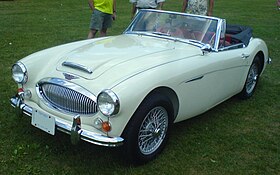Austin-Healey 3000
| Austin-Healey 3000 | |
|---|---|
 |
|
| Overview | |
| Manufacturer | Austin-Healey (BMC) |
| Production | 1959–1967 |
| Assembly | Abingdon, England |
| Body and chassis | |
| Class | Sports car |
| Body style | 2-door roadster |
| Layout | FR layout |
| Powertrain | |
| Engine | 2,912 cc (2.9 L) C-Series I6 |
| Dimensions | |
| Wheelbase | 92 in (2,337 mm) |
| Length | 157 in (3,988 mm) |
| Width | 60 in (1,524 mm) |
| Height | 46 in (1,168 mm) (Hood down) 49.5 in (1,257 mm) (hard top) |
| Curb weight | 2,550 lb (1,157 kg) |
| Chronology | |
| Predecessor | Austin-Healey 100-6 |
| Successor | MG MGC |
The Austin-Healey 3000 is a British sports car built from 1959 to 1967, and is the best known of the "big Healey" models. The car's bodywork was made by Jensen Motors, and the vehicles were assembled by Austin-Healey at the Abingdon works.
The 3-litre 3000 was a highly successful car, which won its class in many European rallies in its heyday and is still raced in classic car competitions by enthusiasts today.
The Austin-Healey 3000 was introduced in 1959, replacing the Austin-Healey 100-6. Despite its new name, the changes were minor compared to those between the original 100 and the 100-6. The wheelbase and body were unchanged, as were the models, a 2+2 and a two-seater.
The original 3000 was built from March 1959 to March 1961 as models BN7 Mark I (2-seater) and BT7 Mark I (2+2 version). It only became known as the Mark I after the Mark II was released, having no designator prior. It featured a 2912 cc I6 engine, with twin SU carburetors and Girling front disc brakes. Wire wheels, overdrive gearbox, laminated windscreen, heater, adjustable steering column, detachable hard top, and two-tone paint were available as options.
A total of 13,650 Mark Is were made (2,825 BN7, and 10,825 BT7).
A BT7 3000 with hardtop and overdrive tested by The Motor magazine in 1960 had a top speed of 115 mph (185 km/h) and could accelerate from 0–60 mph (97 km/h) in 11.7 seconds. A fuel consumption of 21.6 miles per imperial gallon (13.1 L/100 km; 18.0 mpg‑US) was recorded. The test car cost £1326 including taxes.
Introduced in March 1961 as the BN7 Mark II (2-seat) and BT7 Mark II (2+2), the 3000 Mark II series came with three SU HS4 carburettors and an improved camshaft. However, the triple SUs proved difficult to balance and were replaced with two SU HS6 upon the introduction of the BJ7 (2+2) model in January 1962. With its debut the BN7 Mark II was discontinued in March 1962, and the BT7 Mark II in June 1962.
Other changes included a vertical barred front grille, wind-up windows instead of side curtains, an improved hood, and a wrap-around windscreen. Optional extras were similar to the Mark I, although the factory hardtop option was dropped with the BJ7's introduction. From August 1961 a brake servo was also available as an optional extra, which greatly improved braking performance. The BJ7 was discontinued in October 1963 with the introduction of the 3000 Mark III.
...
Wikipedia
